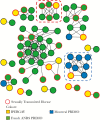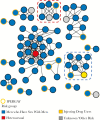In-depth Sampling of High-risk Populations to Characterize HIV Transmission Epidemics Among Young MSM Using PrEP in France and Quebec
- PMID: 30899768
- PMCID: PMC6422434
- DOI: 10.1093/ofid/ofz080
In-depth Sampling of High-risk Populations to Characterize HIV Transmission Epidemics Among Young MSM Using PrEP in France and Quebec
Abstract
Background: A better understanding of HIV transmission dynamics among populations at high risk is important for development of prevention strategies. We determined HIV transmission networks from infected individuals enrolled in the pre-exposure prophylaxis (PrEP) IPERGAY trial in combination with the ANRS PRIMO and Montreal PHI cohorts to identify and characterize active clusters of transmission in this high-risk population.
Methods: Genotypic resistance tests were performed on plasma samples from 31 IPERGAY participants. Reverse transcriptase sequences were analyzed in combination with unique HIV pol sequences from 1351 individuals enrolled in the PRIMO ANRS cohort (1999-2014) and 511 individuals enrolled in the Montreal PHI cohort (1996-2016). Network analyses were performed to infer putative relationships between all participants.
Results: Overall, 1893 participants were included. Transmission network analyses revealed that 14 individuals (45.2%) from the IPERGAY trial were involved in 13 clusters sampled over a median period (interquartile range) of 2 (0.3-7.8) years, including 7 dyads and 6 larger clusters ranging from 4 to 28 individuals. When comparing characteristics between clustering individuals enrolled in the PRIMO cohort (n = 377) and in IPERGAY (n = 14), we found that IPERGAY participants had a higher viral load (5.93 vs 5.20 log10 copies/mL, P = .032) and reported a higher number of partners in the last 2 months (P < .01).
Conclusions: These results demonstrate high rates of HIV transmission clustering among young high-risk MSM enrolled in the IPERGAY trial. In-depth sampling of high-risk populations may help to uncover unobserved transmission intermediaries and improve prevention efforts that could be targeted to the most active clusters.
Keywords: HIV; MSM; PrEP; clustering; network.
Figures


Similar articles
-
Spatiotemporal dynamics of HIV-1 transmission in France (1999-2014) and impact of targeted prevention strategies.Retrovirology. 2017 Feb 21;14(1):15. doi: 10.1186/s12977-017-0339-4. Retrovirology. 2017. PMID: 28222757 Free PMC article.
-
On-demand pre-exposure prophylaxis with tenofovir disoproxil fumarate plus emtricitabine among men who have sex with men with less frequent sexual intercourse: a post-hoc analysis of the ANRS IPERGAY trial.Lancet HIV. 2020 Feb;7(2):e113-e120. doi: 10.1016/S2352-3018(19)30341-8. Epub 2019 Nov 26. Lancet HIV. 2020. PMID: 31784343 Clinical Trial.
-
The ANRS-Ipergay trial, an opportunity to use qualitative research to understand the perception of the "participant"-physician relationship.AIDS Care. 2018 Jun;30(sup2):41-47. doi: 10.1080/09540121.2018.1468013. Epub 2018 May 30. AIDS Care. 2018. PMID: 29848004
-
Uptake of PrEP and condom and sexual risk behavior among MSM during the ANRS IPERGAY trial.AIDS Care. 2016;28 Suppl 1(sup1):48-55. doi: 10.1080/09540121.2016.1146653. Epub 2016 Feb 17. AIDS Care. 2016. PMID: 26883400 Free PMC article.
-
HIV pre-exposure prophylaxis (PrEP): a review of current knowledge of oral systemic HIV PrEP in humans.Infection. 2016 Apr;44(2):151-8. doi: 10.1007/s15010-015-0850-2. Epub 2015 Oct 15. Infection. 2016. PMID: 26471511 Review.
Cited by
-
Longitudinal typing of molecular HIV clusters in a statewide epidemic.AIDS. 2021 Sep 1;35(11):1711-1722. doi: 10.1097/QAD.0000000000002953. AIDS. 2021. PMID: 34033589 Free PMC article.
-
Priority Intervention Targets Identified Using an In-Depth Sampling HIV Molecular Network in a Non-Subtype B Epidemics Area.Front Cell Infect Microbiol. 2021 Mar 29;11:642903. doi: 10.3389/fcimb.2021.642903. eCollection 2021. Front Cell Infect Microbiol. 2021. PMID: 33854982 Free PMC article.
-
Dynamics of clustering rates in the Rhode Island HIV-1 epidemic.AIDS. 2025 Feb 1;39(2):105-114. doi: 10.1097/QAD.0000000000004062. Epub 2024 Nov 8. AIDS. 2025. PMID: 39527774
-
Comparative Circulation Dynamics of the Five Main HIV Types in China.J Virol. 2020 Nov 9;94(23):e00683-20. doi: 10.1128/JVI.00683-20. Print 2020 Nov 9. J Virol. 2020. PMID: 32938762 Free PMC article.
-
Characteristics and growth of the genetic HIV transmission network of Mexico City during 2020.J Int AIDS Soc. 2021 Nov;24(11):e25836. doi: 10.1002/jia2.25836. J Int AIDS Soc. 2021. PMID: 34762774 Free PMC article.
References
-
- Choopanya K, Martin M, Suntharasamai P, et al. . Bangkok Tenofovir Study Group Antiretroviral prophylaxis for HIV infection in injecting drug users in Bangkok, Thailand (the Bangkok Tenofovir Study): a randomised, double-blind, placebo-controlled phase 3 trial. Lancet 2013; 381:2083–90. - PubMed
-
- Thigpen MC, Kebaabetswe PM, Paxton LA, et al. . TDF2 Study Group Antiretroviral preexposure prophylaxis for heterosexual HIV transmission in Botswana. N Engl J Med 2012; 367:423–34. - PubMed
-
- Molina JM, Capitant C, Spire B, et al. . ANRS IPERGAY Study Group On-demand preexposure prophylaxis in men at high risk for HIV-1 infection. N Engl J Med 2015; 373:2237–46. - PubMed
Grants and funding
LinkOut - more resources
Full Text Sources
Miscellaneous

